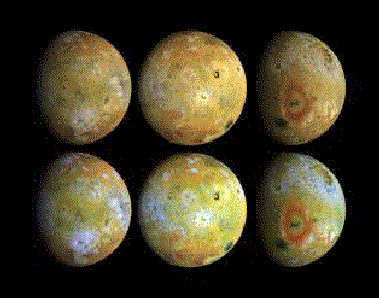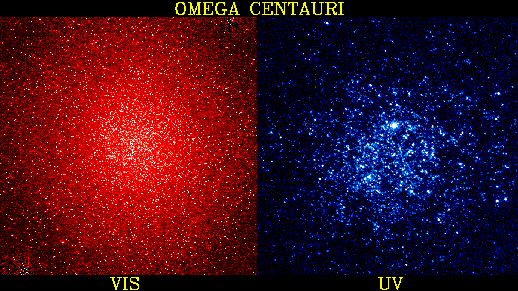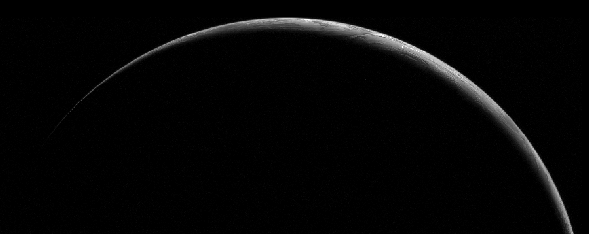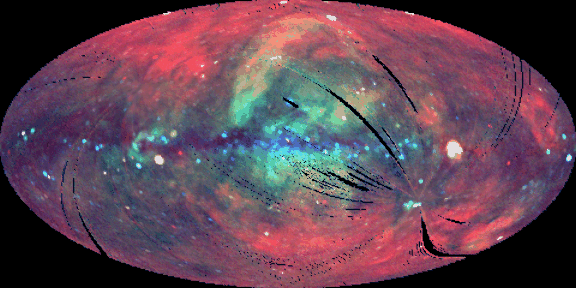NASA APOD #469-477
#469 News Flash: September 30, 1996
“How do planets, stars, and galaxies form? How do they evolve? The International Ultraviolet Explorer (IUE) satellite was launched in 1978 and operated by NASA/ ESA/ PPARC to help provide answers to some of the most fundamental questions about the contents of our universe. IUE served as a geostationary orbiting observatory for the next 18 years acquiring over 100,000 observations with its onboard ultraviolet spectrographs. Its prodigious scientific output is only hinted at by the all-sky plot above which shows the locations of IUE's many pointed observations over its long operational history. The brightness of a point on the sky represents the the number of IUE observations. The plot is in galactic coordinates (the plane of our Galaxy runs horizontally through the middle) and reveals the positions of distant quasars, galaxies, stars, star clusters, nebulae, novae, and supernovae - testifying to IUE's broad range of capabilities. The ecliptic plane is also visible running diagonally through the center, traced out by many observations of solar system objects. After over 18 years, IUE's science operations officially end today as the final commands are transmitted to the aging satellite by controllers at NASA's Goddard Space Flight Center. Astronomers from around the world whose careers have been touched by IUE have expressed their fond farewells to this most productive and longest lived astronomical satellite and their thanks to all who have made IUE's remarkable voyage of exploration possible. News Flash: BATSE Detects Huge Gamma Ray Burst"
Copyright: Public domain
#470 BATSE's Biggest Gamma Ray Burst (Yet)
Credit: October 01, 1996
“Something big exploded but astronomers have no idea what. On September 24th, the Burst and Transient Source Experiment (BATSE) onboard the orbiting Compton Gamma Ray Observatory recorded the most intense gamma ray burst in its five year history. During its mission, BATSE has recorded many gamma ray bursts - about one per day, but none were this powerful. Since their discovery over 25 years ago, the origin and even distance to gamma ray bursts remains hotly debated. Bursts are surely mysterious phenomena: they flash into existence suddenly dominating the entire gamma-ray sky, then typically fade in a few seconds never to be seen again. It is possible that this intense wave of gamma radiation caused other satellites to glitch and may even have been the cause of unusual noise in the Earth's atmosphere. If you know of such an anomaly, please report it. "
Copyright: Public domain
#471 Tomorrow's picture: October 02, 1996
“The Horsehead Nebula is arguably the most famous nebula on the sky. It is visible as the black indentation to the red emission nebula seen just to the right of center of the above photograph. The bright star near the center is located in the belt of the familiar constellation of Orion. The horse-head feature is dark because it is really an opaque dust cloud which lies in front of the bright red emission nebula. Like clouds in Earth's atmosphere, this cosmic cloud has assumed a recognizable shape by chance. After many thousands of years, the internal motions of the cloud will alter its appearance. The emission nebula's red color is caused by electrons recombining with protons to form hydrogen atoms. Also visible in the picture are blue reflection nebulae, which preferentially reflect the blue light from nearby stars."
Copyright: Anglo-Australian Telescope Board
#472 Three Views of Jupiter's Io Credit: October 03, 1996
“The Galileo spacecraft orbiting Jupiter continues to return impressive results. The Galileo team has just released three more photographs of Jupiter's volcanic moon Io taken in June. These three photos are reflected at the bottom of the above picture, digitally enhanced to better show important features. Some areas of Io, it now appears, are truly red, not the usual green and yellow hues recorded previously. In fact, the last major mission - Voyager - did not have cameras sensitive to red light. This red material appears to be associated with recent volcanic eruptions, and the red color appears to fade with time. Comparisons of these photos with 17-year old Voyager photos show that about a dozen surface regions -- each the size of Connecticut-- have been affected by Io's active volcanoes. "
Copyright: Public domain
#473 Globular Cluster Omega Centauri Credit: October 04, 1996
“Does an old, red globular cluster have any hot, blue stars? The rightmost picture, taken by the Ultraviolet Imaging Telescope in ultraviolet light, shows that indeed it does. Pictured, Omega Centauri is the largest known globular cluster in our Galaxy, containing well over a million stars. Many of these stars are evident in the visible light photograph on the left. When photographed in ultraviolet light, however, different and less numerous stars emerge, as evident on the photograph on the right. Most of these stars are thought to have evolved past the current stage of our Sun. These stars no longer fuse hydrogen to helium in their core but rather fuse helium into carbon. These stars will soon shed their outer envelopes and end up as smoldering carbon embers known as white dwarf stars. "
Copyright: Public domain
#474 A Close-Up of the Horsehead Nebula Credit and Copyright: October 05, 1996
“1500 light years away lies a nebula of quite peculiar shape. How did the dark dust cloud shown above come to be shaped like a horse's head? Nobody knows! Barnard 33, as this region is known to some, is surely a dark dust cloud absorbing the light from the bright red emission nebula behind it. The Horsehead Nebula is also thought to be a region where low-mass stars form. But the reason for gross shapes in the universe is frequently poorly understood. Perhaps there is no simple explanation in this case. Some stars are thought to be efficient creators of dust, while others are much better at destroying it. The Horsehead Nebula's dust distribution might just be the result of a specific irregular distribution of stars and gas in its vicinity. "
Copyright: Public domain
#475 A Crescent Earth At Midnight Credit: October 06, 1996
“The Earth's northern hemisphere appears outlined as a sunlit crescent in this dramatic view from the GOES 8 satellite. The image was made near midnight for the Geostationary Operational Environmental Satellite on June 22 this year, two days after the Summer Solstice. The Summer Solstice is the time of year when the sun reaches its greatest northern declination and the arctic regions near the top of the picture experience 24 hours of daylight. Looking south along the Earth's limb, atmospheric scattering of sunlight causes the bright crescent to be visible beyond areas directly illuminated by the sun."
Copyright: Public domain
#476 Io's Shadow Credit: October 07, 1996
“Caught in the act earlier this summer by the Hubble Space Telescope, the volcanic moon Io (above and right of center) and its shadow (black dot) are seen here against Jupiter's clouds. Io's shadow is 2,262 miles in diameter (about the size of Io) as it races across the swirling cloud tops at about 38,000 miles per hour. From our perspective in the inner Solar System, dramatic scenes like this one are possible when Jupiter, Io, and the Sun line up. What would this scene look like when viewed from Jupiter's cloud tops? As the shadow passed over Jupiter, for observers along the shadow's track, Io's disk would appear to eclipse the sun. The situation is familiar to those Earth Dwellers who have seen a Solar Eclipse - visible from along the track of the Moon's shadow passing across the surface of the Earth."
Copyright: Public domain
#477 Tomorrow's picture: October 08, 1996
“Launched in 1990, the orbiting ROSAT observatory explored the Universe by viewing the entire sky in x-rays - photons with about 1,000 times more energy than visible light. This ROSAT survey produced the sharpest, most sensitive image of the x-ray sky to date. The all-sky image is shown with the plane of our Milky Way Galaxy running horizontally through the center. Both x-ray brightness and relative energy are represented with red, green, and blue colors indicating three x-ray energy ranges (from lowest to highest). Bright x-ray spots near the galactic plane are within our own Milky Way. The brightest region (right of center) is toward the Vela Pulsar and the Puppis supernova remnant. Bright sources beyond our Galaxy are also apparent, notably the Virgo cluster of galaxies (near top right) and the Large Magellanic Cloud (LMC). The LMC is easy to find here as several of the black stripes (blank areas caused by missing data) seem to converge on its position (lower right). Over large areas of the sky a general diffuse background of x-rays dominates. Hot gas in our own Galaxy provides much of this background and gives rise to the grand looping structures visible in the direction of the galactic center (image center). Unresolved extragalactic sources also add to this background, particularly above and below the plane. Despite the x-ray sky's exotic appearance, a very familiar feature is visible - the gas and dust clouds which line the plane of our galaxy absorb x-rays as well as optical light and produce the dark bands running through the galactic center."
Copyright: Public domain
Upvote! Resteem! Comment! As you like it! Thank you for attention!








